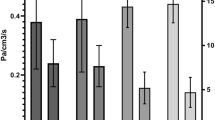Abstract
Objective
The aim of this study is to evaluate the histopathological effects of septoplasty techniques on the nasal septal mucosa of rabbits with light and electron microscope.
Methods
The study was performed on 21 rabbits between August 2016 and February 2017. Rabbits were randomly divided into three groups. In Group-1, while preserving the L-strut structure of the septum, cartilage resection, was performed by open technique septoplasty. In Group-2, the same procedure was done except the resected cartilage was crushed and put back in place. No surgical procedure was performed on the Control group. Postoperative 2nd month; the specimens were histopathologically evaluated by light and electron microscope in terms of changes in the morphology of septum mucosa, perichondrial thickness, cilia and goblet cell deprivation, loss in glands, fibrosis and inflammatory cell infiltration in the lamina propria.
Results
The deprivation in cilia, goblet cells, serous gland and increase in the amount of collagen fibers were examined in both Group-1 and 2. The difference in Group-1 and Group-2 were statistically significant in terms of presence of cilia, number of goblet cells and glands and increase in collagen fibers when compared to control (p < 0.001, p = 0.002, p = 0.020, p = 0.002, respectively). In terms of perichondrium thickness, statistically significant difference was found between the Control and Group-2 (p < 0.001).
Conclusıon
In this study, histopathological findings supported that the presence of cartilage in the septum is necessary to prevent the mucosal changes. Long-term studies are needed to observe whether changes in the morphology of epithelium and gland proceed more than 2 months follow-up.





Similar content being viewed by others
References
Most SP, Rudy SF (2017) Septoplasty: basic and advanced techniques. Facial Plast Surg Clin 25:161-
Hwang PH, McLaughlin RB, Lanza DC, Kennedy DW (1999) Endoscopic septoplasty: indications, technique, and results. Otolaryngol Head Neck Surg 120:678–682
Rosen CA, Johnson JT (2014) Bailey’s head and neck surgery otolaryngology review, 1st edn. Lippincott Williams and Wilkins, Baltimore
Sedaghat AR, Busaba NY, Cunningham MJ, Kieff D (2013) Clinical assessment is an accurate predictor of which patients will need septoplasty. Laryngoscope 123:48–52
Sundh C, Sunnergren O (2015) Long-term symptom relief after septoplasty. Eur Arch Otorhinolaryngol 272:2871–2875
Tsang CLN, Nguyen T, Sivesind T, Cervin A (2018) Long-term patient-related outcome measures of septoplasty: a systematic review. Eur Arch Otorhinolaryngol 275:1039–1048
Türk B, Akpinar M, Altundağ A, Kirik M, Ünsal Ö, Coşkun BU (2017) The effect of external approach septoplasty on olfactory function. J Craniofacial Surg 28:1675–1678
Huizing EH, De Groot JW (2003) Functiona reconstructive nasal surgery, 1st edn. Thieme, New York
Jang YJ, Myong NH, Park KH, Koo TW, Kim HG (2002) Mucociliary transport and histologic characteristics of the mucosa of deviated nasal septum. Arch Otolaryngol Head Neck Surg 128:421–424
Mariappan RG, Dhanalakshmiv M, Mathaikutty DM, Shanmugam R, Shanmugam VU, Swaminathan B, Nandipati S (2014) Clinico-pathological correlation and the effect of septal surgery on nasal mucociliary clearance. Sch J App Med Sci 2:1691–1695
Melgarejo Moreno P, Hellín Meseguer D (2006) Submucosal glands and goblet cells in maxillary sinus surgery: an experimental study in rabbits. Rhinology 44:259–263
Anselmo-Lima WT, Ferreira MD, Valera FC, Rossato M, de Mello VR, Demarco RC (2007) Histological evaluation of maxillary sinus mucosa after functional endoscopic sinus surgery. Am J Rhinol Allergy 21:719–724
Ateşpare A, Üstündağ E, Dalçık H, Çelik Ö (2015) Mucociliary transport and histopathological changes in rotation flaps of the nasal mucosa. Eur Arch Otorhinolaryngol 272:1143–1148
Khalmuratova R, Jeon SY, Kim DW, Kim JP, Ahn SK, Park JJ, Hur DG (2009) Wound healing of nasal mucosa in a rat. Am J Rhinol Allergy 23:33–37
Author information
Authors and Affiliations
Corresponding author
Ethics declarations
Conflict of interest
The authors do not have any conflicts of interest. No financial support was obtained for this study.
Ethical approval
The study was conducted after the approval of Animal Experiments Ethical Committee of our Hospital (date:Aug 16, 2016-decree no: 0034/438).
Rights and permissions
About this article
Cite this article
Ozdemir, S., Celik, H., Cengiz, C. et al. Histopathological effects of septoplasty techniques on nasal septum mucosa: an experimental study. Eur Arch Otorhinolaryngol 276, 421–427 (2019). https://doi.org/10.1007/s00405-018-5226-7
Received:
Accepted:
Published:
Issue Date:
DOI: https://doi.org/10.1007/s00405-018-5226-7




